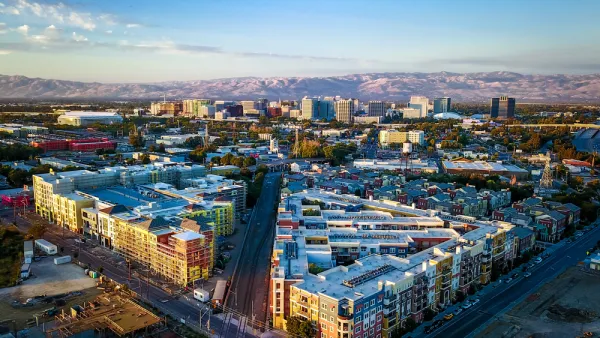The San Diego Association of Governments requested that the number of new housing units that the state housing agency assign the state's second largest county be reduced to more accurately reflect what the 18 cities and county can actually build.

"Board members of the San Diego Association of Governments [SANDAG] on Friday voted to ask state officials to set a lower bar for housing production in the county, reflecting a resistance among elected officials to allow for more homes to be built despite a crippling housing crisis," reports Andrew Bowen for KPBS on May 11. They approved the staff recommendation "to better reflect realistic conditions in the region."
The Regional Housing Needs Assessment is a state-mandated program that requires cities and counties to plan for enough homes to accommodate their expected population growth. The state has asked SANDAG to plan for more than 171,000 new homes to be built in the county between 2021 and 2029.
The county is nearing its 2020 deadline for the current cycle of housing goals, but governments have permitted less than a third of the homes allowed for in their current plans.
According to Scott Lewis and Andrew Keatts of the Voice of San Diego, SANDAG staff had recommended that the goal be reduced by 32 percent to 116,000 units.
Very few jurisdictions, 2.4 percent, to be precise, in the state actually meet the goals assigned to them by the California Department of Housing and Community Development (HCD). In San Diego County, Lemon Grove, population 25,000, was among the 13 cities that met their requirement for the 2016 reporting period.
"Maya Rosas, director of policy for the smart-growth advocacy nonprofit Circulate San Diego, said her organization was disappointed by Friday's vote," writes Bowen.
"A vote to reduce the number of homes the region is required to accommodate does not reduce the need for homes for San Diego families," she said in an email. "Today's action only makes it harder for the region to grow and to retain its families and workforce."
Bowen notes that California ranks 49th in the country in terms of housing production per capita.
New legislation could have changed board vote on housing goal
Last October, Gov. Jerry Brown (D) signed Assembly Bill 805 authored by California State Assemblywoman Lorena Gonzalez Fletcher (D-San Diego) that reformed SANDAG by, among other things, changing the voting structure by allowing for a "weighted vote" based on the population of the 18 cities and unincorporated county.
The motion to ask the state for lower housing goals passed with 67 percent of the board members' "yes" votes. Had a weighted vote been called, the motion could have failed because the board members supporting the more ambitious housing goals appeared to represent a majority of the county's population.
The text of AB 805 indicates that "a weighted vote may be called by the members of any two jurisdictions." While Bowen doesn't indicate why board members who opposed the motion didn't call for such a vote, Lewis and Keatts offered three possibilities:
- They forgot.
- They didn’t want to play hardball.
- The “no” votes were just for show.
Hat tip to MTC-ABAG Library.
FULL STORY: SANDAG Board Asks State To Lower The Bar On Housing

National Parks Layoffs Will Cause Communities to Lose Billions
Thousands of essential park workers were laid off this week, just before the busy spring break season.

Retro-silient?: America’s First “Eco-burb,” The Woodlands Turns 50
A master-planned community north of Houston offers lessons on green infrastructure and resilient design, but falls short of its founder’s lofty affordability and walkability goals.

Delivering for America Plan Will Downgrade Mail Service in at Least 49.5 Percent of Zip Codes
Republican and Democrat lawmakers criticize the plan for its disproportionate negative impact on rural communities.

Test News Post 1
This is a summary

Test News Headline 46
Test for the image on the front page.

Balancing Bombs and Butterflies: How the National Guard Protects a Rare Species
The National Guard at Fort Indiantown Gap uses GIS technology and land management strategies to balance military training with conservation efforts, ensuring the survival of the rare eastern regal fritillary butterfly.
Urban Design for Planners 1: Software Tools
This six-course series explores essential urban design concepts using open source software and equips planners with the tools they need to participate fully in the urban design process.
Planning for Universal Design
Learn the tools for implementing Universal Design in planning regulations.
EMC Planning Group, Inc.
Planetizen
Planetizen
Mpact (formerly Rail~Volution)
Great Falls Development Authority, Inc.
HUDs Office of Policy Development and Research
NYU Wagner Graduate School of Public Service





























